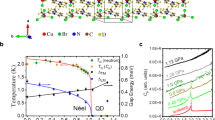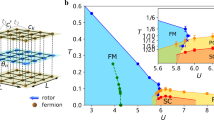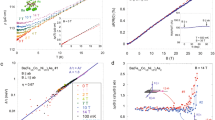Abstract
Advances in solid-state and atomic physics are exposing the hidden relationships between conventional and exotic states of quantum matter. Prominent examples include the discovery of exotic superconductivity proximate to conventional spin and charge order1,2, and the crossover from long-range phase order to preformed pairs achieved in gases of cold fermions3,4,5 and inferred for copper oxide superconductors5. The unifying theme is that incompatible ground states can be connected by quantum phase transitions. Quantum fluctuations about the transition are manifestations of the competition between qualitatively distinct organizing principles6,7, such as a long-wavelength density wave and a short-coherence-length condensate. They may even give rise to ‘protected’ phases, like fluctuation-mediated superconductivity that survives only in the vicinity of an antiferromagnetic quantum critical point8,9. However, few model systems that demonstrate continuous quantum phase transitions have been identified, and the complex nature of many systems of interest hinders efforts to more fully understand correlations and fluctuations near a zero-temperature instability. Here we report the suppression of magnetism by hydrostatic pressure in elemental chromium, a simple cubic metal that demonstrates a subtle form of itinerant antiferromagnetism10,11,12,13,14,15,16 formally equivalent to the Bardeen–Cooper–Schrieffer (BCS) state in conventional superconductors. By directly measuring the associated charge order in a diamond anvil cell at low temperatures, we find a phase transition at pressures of ∼10 GPa driven by fluctuations that destroy the BCS-like state but preserve the strong magnetic interaction between itinerant electrons and holes. Chromium is unique among stoichiometric magnetic metals studied so far in that the quantum phase transition is continuous, allowing experimental access to the quantum singularity and a direct probe of the competition between conventional and exotic order in a theoretically tractable material.
This is a preview of subscription content, access via your institution
Access options
Subscribe to this journal
Receive 51 print issues and online access
$199.00 per year
only $3.90 per issue
Buy this article
- Purchase on Springer Link
- Instant access to full article PDF
Prices may be subject to local taxes which are calculated during checkout




Similar content being viewed by others
References
de la Cruz, C. et al. Magnetic order close to superconductivity in the iron-based layered LaO1-x F x FeAs systems. Nature 453, 899–902 (2008)
Morosan, E. et al. Superconductivity in Cu x TiSe2 . Nature Phys. 2, 544–550 (2006)
Regal, C. A., Greiner, M. & Jin, D. S. Observation of resonance condensation of fermionic atom pairs. Phys. Rev. Lett. 92, 040403 (2004)
Chin, C. et al. Observation of the pairing gap in a strongly interacting Fermi gas. Science 305, 1128–1130 (2004)
Chen, Q., Stajic, J., Tan, S. & Levin, K. BCS-BEC crossover: from high temperature superconductors to ultracold superfluids. Phys. Rep. 412, 1–88 (2005)
Sachdev, S. Quantum criticality: competing ground states in low dimensions. Science 288, 475–480 (2000)
Coleman, P. & Schofield, A. J. Quantum criticality. Nature 433, 226–229 (2005)
Nagaosa, N. Superconductivity and antiferromagnetism in high-TC cuprates. Science 275, 1078–1079 (1997)
Broun, D. M. What lies beneath the dome? Nature Phys. 4, 170–172 (2008)
Fawcett, E. Spin-density-wave antiferromagnetism in chromium. Rev. Mod. Phys. 60, 209–283 (1988)
McWhan, D. B. & Rice, T. M. Pressure dependence of itinerant antiferromagnetism in chromium. Phys. Rev. Lett. 19, 846–849 (1967)
Yeh, A. et al. Quantum phase transition in a common metal. Nature 419, 459–462 (2002)
Lee, M., Husmann, A., Rosenbaum, T. F. & Aeppli, G. High resolution study of magnetic ordering at absolute zero. Phys. Rev. Lett. 92, 187201 (2004)
Feng, Y. et al. Pressure-tuned spin and charge ordering in an itinerant antiferromagnet. Phys. Rev. Lett. 99, 137201 (2007)
Jaramillo, R. et al. Chromium at high pressures: weak coupling and strong fluctuations in an itinerant antiferromagnet. Phys. Rev. B 77, 184418 (2008)
Overhauser, A. W. Spin density waves in an electron gas. Phys. Rev. 128, 1437–1452 (1962)
Young, C. Y. & Sokoloff, J. B. The role of harmonics in the first order antiferromagnetic to paramagnetic transition in chromium. J. Phys. F 4, 1304–1319 (1974)
Hill, J. P., Helgesen, G. & Gibbs, D. X-ray-scattering study of charge- and spin-density waves in chromium. Phys. Rev. B 51, 10336–10344 (1995)
Pfleiderer, C. Why first order quantum phase transitions are interesting. J. Phys. Condens. Matter 17, S987–S997 (2005)
Werner, S. A., Arrott, A. & Kendrick, H. Temperature and magnetic-field dependence of the antiferromagnetism in pure chromium. Phys. Rev. 155, 528–539 (1967)
Rice, T. M. Band-structure effects in itinerant antiferromagnetism. Phys. Rev. B 2, 3619–3630 (1970)
Sokolov, D. A. et al. Elastic neutron scattering in quantum critical antiferromagnet Cr0. 963V0. 037 . Physica B (Amsterdam) 403, 1276–1278 (2008)
Schroder, A., Aeppli, G., Bucher, E., Ramazashvili, R. & Coleman, P. Scaling of magnetic fluctuations near a quantum phase transition. Phys. Rev. Lett. 80, 5623–5626 (1998)
Sweetland, E., Tsai, C.-Y., Wintner, B. A., Brock, J. D. & Thorne, R. E. Measurement of the charge-density-wave correlation length in NbSe3 by high-resolution X-ray scattering. Phys. Rev. Lett. 65, 3165–3168 (1990)
DeLand, S. M., Mozurkewich, G. & Chapman, L. D. X-ray investigation of charge-density-wave pinning in blue bronze. Phys. Rev. Lett. 66, 2026–2029 (1991)
Gegenwart, P. et al. Multiple energy scales at a quantum critical point. Science 315, 969–971 (2007)
Giamarchi, T., Rüegg, C. & Tchernyshoyov, O. Bose–Einstein condensation in magnetic insulators. Nature Phys. 4, 198–204 (2008)
Feng, Y. et al. Energy dispersive X-ray diffraction of charge density waves via chemical filtering. Rev. Sci. Instrum. 76, 063913 (2005)
Strempfer, J. et al. Form-factor measurements on chromium with high-energy synchrotron radiation. Eur. Phys. J. B 14, 63–72 (2000)
Rice, T. M., Barker, A. S., Halperin, B. I. & McWhan, D. B. Antiferromagnetism in chromium and its alloys. J. Appl. Phys. 40, 1337–1343 (1969)
Acknowledgements
We are grateful to J. Pluth for assistance with sample preparation, V. Prakapenka and GeoSoilEnviroCARS (Advanced Photon Source (APS), Argonne National Laboratory) for technical support and G. Aeppli for many discussions. The work at the University of Chicago was supported by the US National Science Foundation (NSF) Division of Materials Research. GeoSoilEnviroCARS is supported by the US NSF Earth Sciences and Department of Energy (DOE) Geosciences. Use of APS is supported by the US DOE Office of Basic Energy Sciences.
Author information
Authors and Affiliations
Corresponding author
Supplementary information
Supplementary Figure
This file contains Supplementary Figure S1 with Legend. (PDF 42 kb)
Rights and permissions
About this article
Cite this article
Jaramillo, R., Feng, Y., Lang, J. et al. Breakdown of the Bardeen–Cooper–Schrieffer ground state at a quantum phase transition. Nature 459, 405–409 (2009). https://doi.org/10.1038/nature08008
Received:
Accepted:
Issue Date:
DOI: https://doi.org/10.1038/nature08008
This article is cited by
-
Phonon-assisted formation of an itinerant electronic density wave
Communications Physics (2022)
-
Characterization of the high-pressure and high-temperature phase diagram and equation of state of chromium
Scientific Reports (2022)
-
Field-induced quantum critical point in the itinerant antiferromagnet Ti3Cu4
Communications Physics (2022)
-
Spatially inhomogeneous competition between superconductivity and the charge density wave in YBa2Cu3O6.67
Nature Communications (2020)
-
Tunable quantum critical point and detached superconductivity in Al-doped CrAs
npj Quantum Materials (2019)
Comments
By submitting a comment you agree to abide by our Terms and Community Guidelines. If you find something abusive or that does not comply with our terms or guidelines please flag it as inappropriate.



